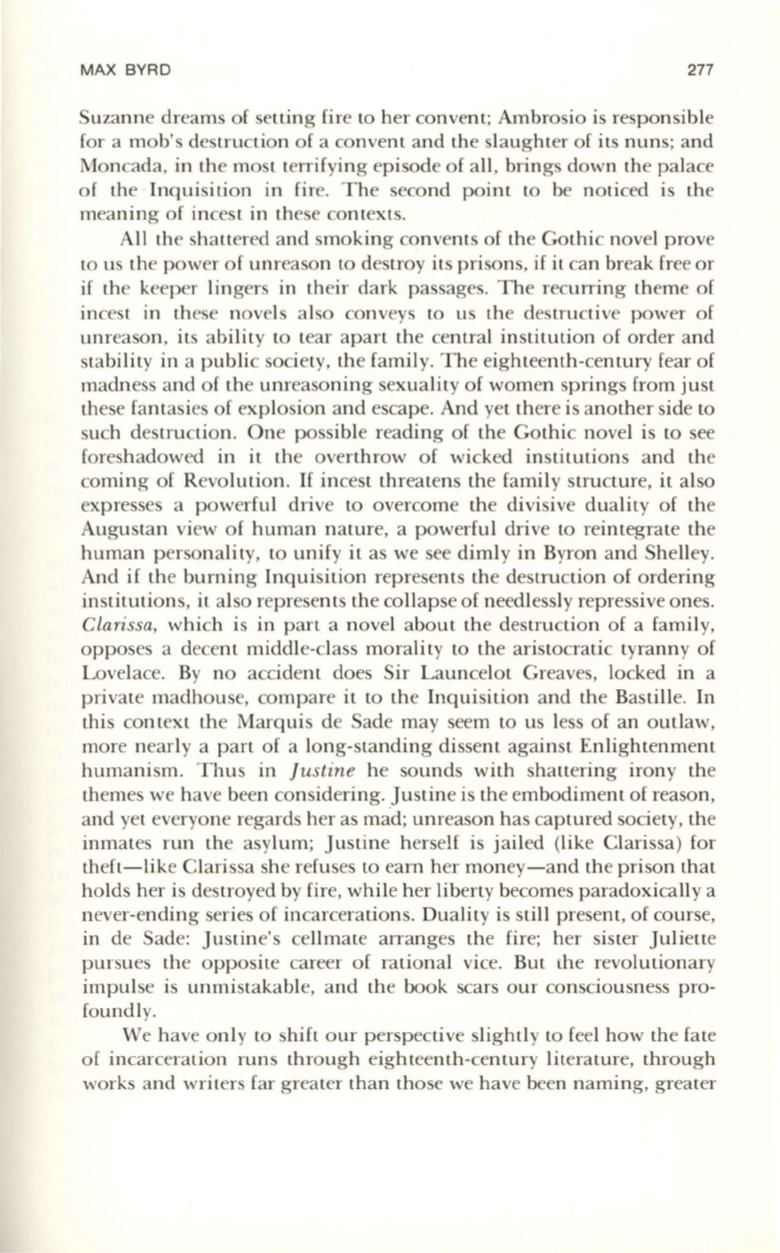
MAX BYRD
277
Suzanne dreams of setting fire to her convent; Ambrosio is responsible
for a mob's destruction of a convent and the slaughter of its nuns; and
Moncada, in the most terrifying episode of all, brings down the palace
of the ' Inquisition in fire. The second point
to
be noticed is the
meaning of incest in these contexts.
All the shattered and smoking convents of the Gothic novel prove
to us the power of unreason
to
destroy its prisons, if it can break free or
if the keeper lingers in their dark passages. The recurring theme of
incest in these novels also conveys
to
us the destructive power of
unreason, its ability to tear apart the central institution of order and
stability in a public society, the family. The eighteenth-century fear of
madness and of the unreasoning sexuality of women springs from just
these fantasies of explosion and escape. And yet there is another side to
such destruction. One possible reading of the Gothic novel is to see
foreshadowed in it the overthrow of wicked institutions and the
coming of Revolution.
If
incest threatens the family structure, it also
expresses a powerful drive to overcome the divisive duality of the
Augustan view of human nature, a powerful drive to reintegrate the
human personality,
to
unify it as we see dimly in Byron and Shelley.
And if the burning Inquisition represents the destruction of ordering
institutions, it also represents the collapse of needlessly repressive ones.
Clarissa,
which is in part a novel about the destruction of a family,
opposes a decent middle-class morality to the aristocratic tyranny of
Lovelace. By no accident does Sir Launcelot Greaves, locked in a
private madhouse, compare it to the Inquisition and the Bastille. In
this context the Marquis de Sade may seem
to
us less of an outlaw,
more nearly a part of a long-standing dissent against Enlightenment
humanism. Thus in
Justine
he sounds with shattering irony the
themes we have been considering. Justine is the embodiment of reason,
and yet everyone regards her as mad; unreason has captured society, the
inmates run the asylum; Justine herself is jailed (like Clarissa) for
theft-like Clarissa she refuses to earn her money-and the prison that
holds her is destroyed by fire, while her liberty becomes paradoxically a
never-ending series of incarcerations. Duality is still present, of course,
in de Sade: justine's cellmate arranges the fire; her sister Juliette
pursues the opposite career of rational vice. But the revolutionary
impulse is unmistakable, and the book scars our consciousness pro–
foundly.
We have only
to
shift our perspective slightly
to
feel how the fate
of incarceration runs through eighteenth-century literature, through
works and writers far greater than those we have been naming, greater


